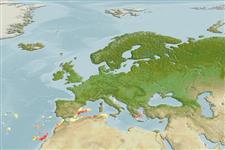Teleostei (teleosts) >
Gobiiformes (Gobies) >
Gobiidae (Gobies) > Gobiinae
Eponymy: The ‘Vanneau’ was the name of the ship from which the type species, V. dollfusi, was collected. Dr Georges Florentin Pruvôt (1852–1924) was a French physician and zoologist, and also Fage’s teacher. [...] (Ref. 128868), visit book page.
Environment: milieu / climate zone / depth range / distribution range
Ecology
Marine; demersal; depth range 60 - 270 m (Ref. 5299). Subtropical
Eastern Atlantic: Canary Islands (Gran Canaria, Tenerife). Also known from the Balearic Islands in the western Mediterranean.
Size / Weight / Age
Maturity: Lm ? range ? - ? cm
Max length : 3.9 cm TL male/unsexed; (Ref. 5299)
Short description
Identification keys | Morphology | Morphometrics
Distinguished by having the following characteristics: Reduced suckers (Ref. 92840).
Occurs offshore, on coralline and other coarse grounds (Ref. 5299).
Life cycle and mating behavior
Maturity | Reproduction | Spawning | Eggs | Fecundity | Larvae
Miller, P.J., 1990. Gobiidae. p. 925-951. In J.C. Quero, J.C. Hureau, C. Karrer, A. Post and L. Saldanha (eds.) Check-list of the fishes of the eastern tropical Atlantic (CLOFETA). JNICT, Lisbon, SEI, Paris; and UNESCO, Paris. Vol. 2. (Ref. 5299)
IUCN Red List Status (Ref. 130435: Version 2024-1)
Threat to humans
Harmless
Human uses
Tools
Special reports
Download XML
Internet sources
Estimates based on models
Preferred temperature (Ref.
123201): 13.2 - 15.8, mean 14.3 °C (based on 19 cells).
Phylogenetic diversity index (Ref.
82804): PD
50 = 0.6250 [Uniqueness, from 0.5 = low to 2.0 = high].
Bayesian length-weight: a=0.00724 (0.00339 - 0.01546), b=3.10 (2.92 - 3.28), in cm total length, based on LWR estimates for this (Sub)family-body shape (Ref.
93245).
Trophic level (Ref.
69278): 3.1 ±0.3 se; based on size and trophs of closest relatives
Resilience (Ref.
120179): High, minimum population doubling time less than 15 months (Preliminary K or Fecundity.).
Fishing Vulnerability (Ref.
59153): Low vulnerability (10 of 100).
